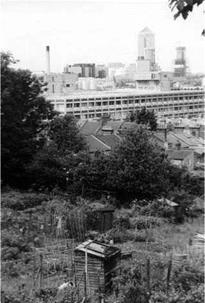H. F. Cook, H. C. Lee and A. Perez-Vazquez
In Britain, the allotment garden has long been a part of working-class culture, and the practice has survived the widespread availability of cheap food, post Second World War. Today, urban and peri-urban agriculture (UPA) in Britain continues to be useful as a means of supplying some food and financial income to urban people (Garnett, 1996a, b; Rees and Wackernagel, 1996; Dunnett and Qasim, 2000), but it also has many other important benefits:
1. social (leisure, empowering local groups of people such as women, therapy for people with special needs, rehabilitation for young offenders).
2. environmental (renovation of derelict urban sites, diversifying urban land use, increasing biodiversity, reducing the ecological footprint).
3. human (encouraging personal qualities such as altruism, improving quality of life by social contact, health benefits of exercise, better quality and more diverse food intake).
4. economic – stimulating local economies.
This chapter will focus upon UPA in Britain and will consider allotments and smaller, less-regulated urban plots of land. Most information in the literature refers to allotments and this will be the main focus. The key issues that will be addressed are:
1. the organisation of allotments and implications for urban planners.
2. practical production issues, including implications for soil contamination and water pollution.
3. the economic implications of allotment gardening in Britain.
THE ORGANISATION OF ALLOTMENTS
In Britain, allotments are defined as pieces of land in cities and towns provided either by local authorities
|
Figure 20.1 |
or landlords where plot holders grow their own food, mainly vegetables and soft-fruits for self-consumption and for their families (House of Commons, 1998).The concept of ‘plots’ is more recent and usually describes individual parcels of land close to houses in urban areas. They are smaller than allotments, variable in size and utilised by people opportunistically, on an ad hoc basis (Perez-Vazquez, 2000). UPA has special relevance to the present day, as a means of reducing food’s ‘ecological footprint.’ Therefore, allotments are increasingly seen in Britain as an integral and diverse component of the urban landscape in London and elsewhere.
Figure 20.2 Urban allotments in London, looking towards Canary Wharf.
|
Figure 20.2 |
There are approximately 296 900 allotments in England across 7800 sites, covering a total of 10290 hectares. This equates to one allotment for every 65 households (NSALG, 2000). Prime examples near London include the Lee Valley and the ‘green finger’ area along the Hogsmill river south-west of London (NRA, 1994). Urban food growing in London covers about 30000 active allotment holders gardening a total of 831 hectares. In London there are also about 77 community gardens and 18 city farms, school gardening projects and countless individuals who grow food in small plots – from a few herbs and a tomato plant upwards – in their back gardens, see: http://www2.essex. ac. uk/ ces/ConfsVisitsEvsGrps/LocalFoodSystems/local – foodtg. htm





